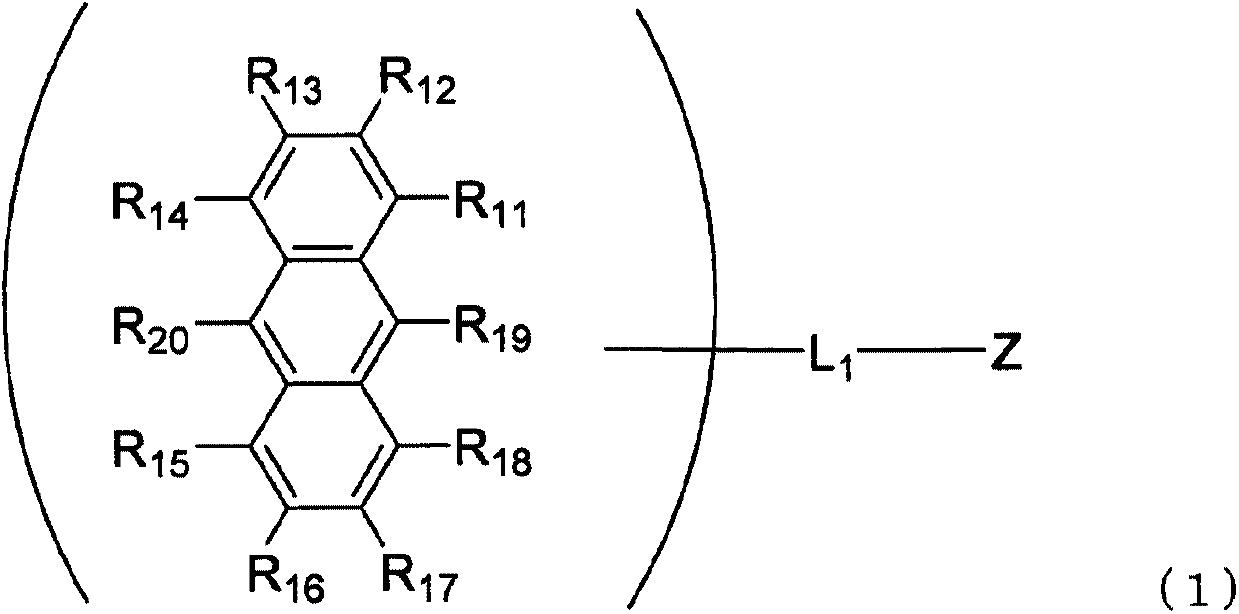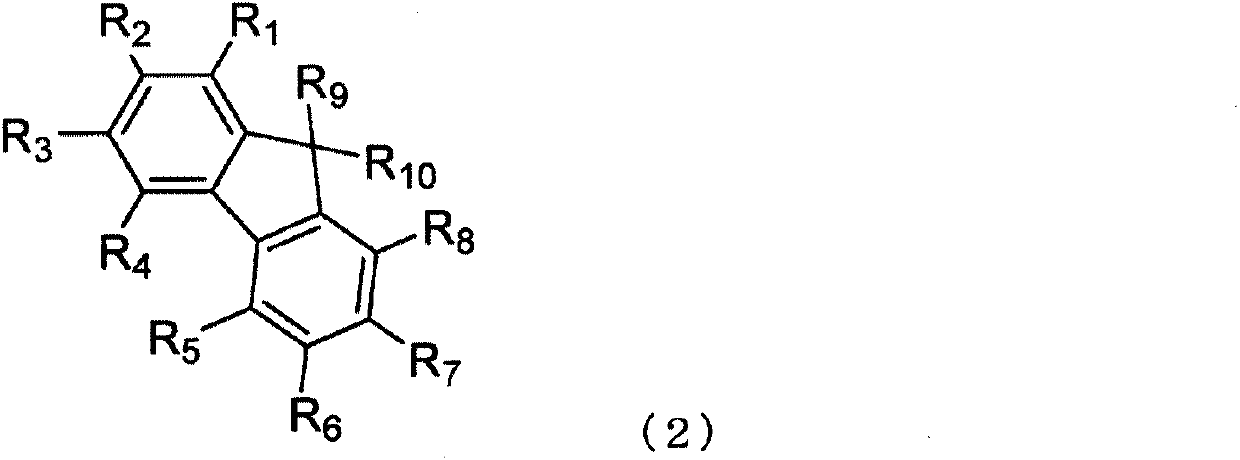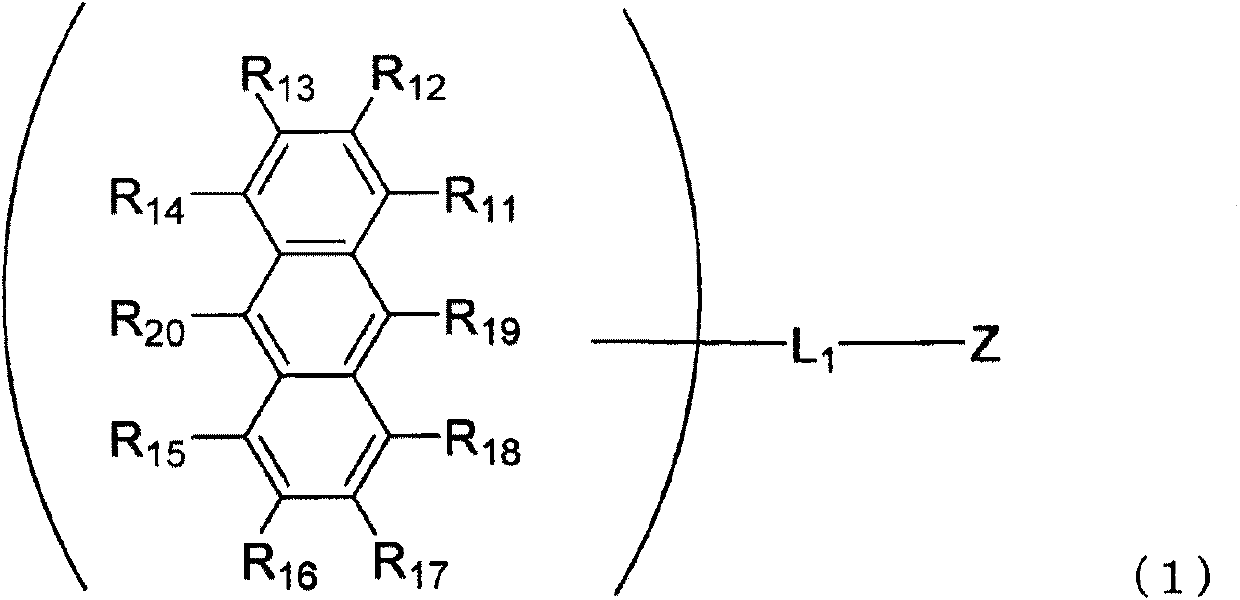Anthracene derivative and organic electroluminescence device using the anthracene derivative
An anthracene derivative and electroluminescence technology, applied in the field of anthracene derivatives, can solve problems such as decreased efficiency and achieve the effect of high luminous efficiency
- Summary
- Abstract
- Description
- Claims
- Application Information
AI Technical Summary
Problems solved by technology
Method used
Image
Examples
Synthetic example 1
[0343] Synthesis Example 1 [Synthesis of Intermediate A]
[0344] Intermediate A was synthesized according to the following scheme.
[0345] 【Chemical 86】
[0346]
[0347] (A-1) Synthesis of ethyl 4-bromo-2-iodobenzoate
[0348] Under an argon atmosphere, 36 mL of tetramethylpiperidine was added to 500 mL of THF (tetrahydrofuran), cooled to 0° C., 90 mL of 2.6 M n-BuLi hexane solution was added dropwise, and stirred at 0° C. for 10 minutes.
[0349] In another flask, a 1.6 M t-BuLi pentane solution was added dropwise to 440 mL of a THF solution (0.5 M) of zinc chloride at 0° C. under an argon atmosphere, followed by stirring for 30 minutes. After the tetramethylpiperidine solution was cooled to -78°C, the di-tert-butylzinc solution prepared in another flask was added dropwise. After raising the temperature of the reaction solution to 0°C, it was stirred for 30 minutes, and then cooled to -78°C again. After adding 22.9 g of ethyl 4-bromobenzoate dropwise, stirring was c...
Synthetic example 2
[0356] Synthesis Example 2 [Synthesis of Intermediate B]
[0357] Intermediate B was synthesized according to the following scheme.
[0358] 【Chemical 87】
[0359]
[0360] In the synthesis of the intermediate (A), the intermediate (B) was synthesized in the same manner as the intermediate (A) except that methyl 2-bromobenzoate was used instead of ethyl 4-bromobenzoate.
Synthetic example 3
[0361] Synthesis Example 3 [Synthesis of Intermediate C]
[0362] Intermediate C was synthesized according to the following scheme.
[0363] 【Chemical 88】
[0364]
[0365] (C-1) Synthesis of 2-acetyl-1-naphthyl trifluoromethanesulfonate
[0366] Under an argon atmosphere, 186 g of 1'-hydroxy-2'-naphthophenone and 18.2 g of 4-dimethylaminopyridine were added to the flask, 4 L of dichloromethane was added, and the flask was cooled to -78°C. After adding 161 g of 2,6-lutidine, 339 g of trifluoromethanesulfonic anhydride was added dropwise. Stirring was continued for 5 hours while raising the temperature to room temperature. The precipitated solid was collected by filtration, washed with water and methanol, and dried to obtain 286 g of triphenylene trifluoromethanesulfonate (90% yield).
[0367] (C-2) Synthesis of 2-acetylnaphthalene-1-boronic acid pinacol ester
[0368] Under an argon atmosphere, add 2-acetyl-1-naphthyl trifluoromethanesulfonate 286g, biboronic acid pina...
PUM
| Property | Measurement | Unit |
|---|---|---|
| electron work function | aaaaa | aaaaa |
| visible light transmittance | aaaaa | aaaaa |
| current density | aaaaa | aaaaa |
Abstract
Description
Claims
Application Information
 Login to View More
Login to View More - R&D
- Intellectual Property
- Life Sciences
- Materials
- Tech Scout
- Unparalleled Data Quality
- Higher Quality Content
- 60% Fewer Hallucinations
Browse by: Latest US Patents, China's latest patents, Technical Efficacy Thesaurus, Application Domain, Technology Topic, Popular Technical Reports.
© 2025 PatSnap. All rights reserved.Legal|Privacy policy|Modern Slavery Act Transparency Statement|Sitemap|About US| Contact US: help@patsnap.com



